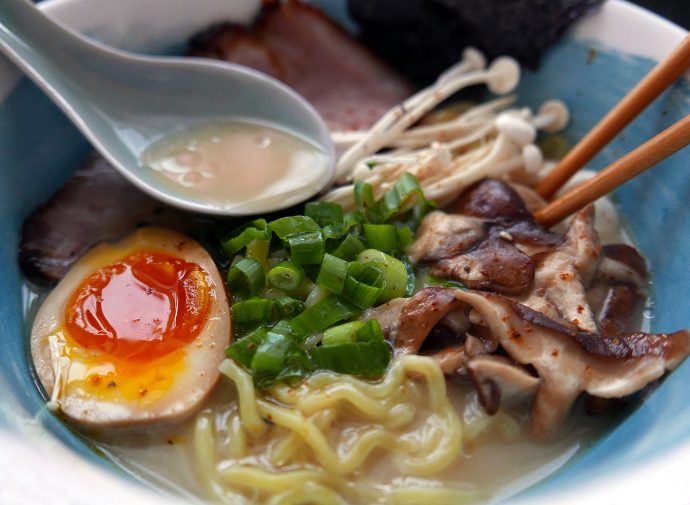I’ve tasted hundreds of bowls of ramen in my existence, from the first cheap fifty cent bowls of Maruchan, to soup truck bowls, to higher end bowls from fine Japanese restaurants. I prefer tonkotsu (pork) ramen to any other form, as this soup has what I search for in my quest for the perfect ramen. What I’m looking for is the mouth feel and flavor of the broth, the chewiness and bounce of the noodles, and finally, the toppings, which are legion.
Great broth should have a rich layering of flavors coming from the lengthy bone boiling process and final aromatic additions. The tare, which is where most of the umami and saltiness come from, should add to that depth, not only with the biting taste of salt, but also with a hint of sweetness coming from sake and mirin, as well as a hint of the sea from fish based ingredients and seaweed. A tonkotsu paitan broth means a water and fat mixture emulsified with collagen. Accordingly, a great ramen for me coats the tongue in a way that most broths, especially from the store shelf, cannot. Ramen should be piping hot, preferably served in a bowl that has also been preheated to keep the broth warm. To also be aesthetically pleasing, a great ramen broth should be as near to white as possible, resembling skim milk, with little particulate matter floating around. This can only be accomplished by thoroughly rinsing bones as you begin and carefully skimming the meat stock as it cooks.
Noodles are huge in the ramen world, so big that often people think of ramen as just the noodles themselves, rather than the complete soup. Great adjectives for ramen noodles are bouncy, springy, stretchy, and elastic. Noodles in a great bowl of ramen have a delicious “chew,” or bounciness when eaten that is not found in Italian pastas, soba or even udon. The noodles should be chewy in a way pasta cooked al dente can only dream about. They should be fairly salty and slightly eggy tasting, but not soapy. Noodles absolutely make the dish, and without good noodles, there is no vehicle for that luscious broth.
Finally, and perhaps most varied and up for interpretation, are the myriad toppings for ramen. As ramen is a fairly modern Japanese food, gaining popularity in just the last century, it is still fully open to improvisation. Requirements for a great bowl of tonkotsu ramen are sliced chashu (braised pork) and ajitsuke tamago (seasoned egg). Beyond that, I like the sour splash of pickled shitake mushrooms, along with slightly bitter boiled spinach, some scallion oil for a toasty mild onion flavor or chili oil for heat, and sliced scallions for a fresh and crunchy, oniony punch. Dried seaweed, or nori adds a nice taste of the ocean. Many other toppings work well, such as enoki mushrooms, mayu (black garlic oil), wood ear mushrooms, crispy chicken skins, and menma (fermented bamboo shoots). What is important to me is that, from a flavor standpoint, everything should have a reason for being in the bowl.


Learned a lot about Ramen that I never knew. I always wondered what was so special about it, now I know! Thanks for sharing this story, and good luck with the discoveries ahead.
Thanks, Justin, for your description appreciating the flavour and qualities of ramen. I’m a Japanese-American (3rd generation) who has been to Japan a few times to experience ramen and udon from Hokaido to Kyushu and I’m usually so hungry when I’m eating (slurpping) them, that I forget to take the time to appreciate the things you point out. I’ll have to curb my hunger in the future, or be more mindful of the experience! Roy.
Loved reading the article! Ramen is still a relatively new entrant in the Indian culinary scene. We have some really nice options available but sadly, “authenticity” gives way, in most cases, to local tastes.